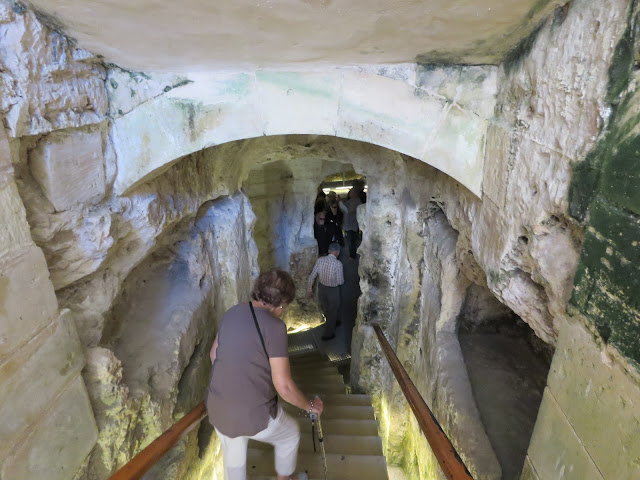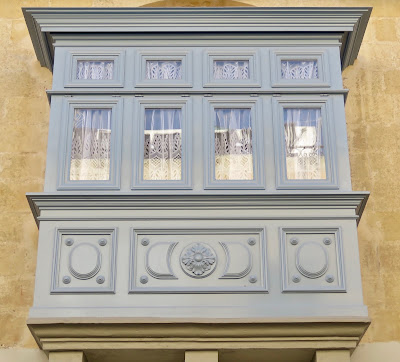I haven't said much about dining on the Marina, but we have eaten quite well. Because Anita was with us we ate more than we usually do in the Grand Dining Room where the highlight was a superb herb-crusted rack of lamb. We especially enjoyed our meals at the four specialty restaurants, eating twice at tow of them, Red Ginger and Toscana. We even made it to High Tea one afternoon, and enjoyed many mid-morning specialty coffees prepared by the excellent barista, Mario (who doubled as the olive oil sommelier in Toscana--don't ask!). And, of course, our Butler, Manny, served hot breakfast in our suite on the mornings on which we had early shore excursions.
Malta, Day 2, Part 1
Saturday, 18 November 2017
This morning we are ready for our shore excursion to the western side of Malta, visiting the Dingli Cliffs, the city of Rabat, and the former capital, Mdina, known as "The Quiet City," since no motor vehicles except those belonging to residents, are allowed within the walls.
The Dingli Cliffs stand at the highest point on Malta (not really very high at all, about 300 meters) and cascade down to the sea. The sides of the cliffs are awash in lovely greens and have been cultivated with trees and small vegetable gardens. Given its position, the site is also home to a radar outpost used by the Allies in WWII and by NATO in our own times.
Just inland from the cliffs sits the city of Rabat, which we are visiting to see the Christian catacombs beautifully excavated and preserved, with an excellent small museum providing background and history. We enter one deep maze of underground tunnels through a long and steep stone staircase. Our guide, who has started an historical introduction in the museum, continues her presentation underground. Afterward, we are free to wander through the well-lit pathways connecting various grave sites.
The eastern edge of Rabat is the demarcation line for the medieval city of Mdina, former capital and current tourist favorite. Buses and cars of visitors are allowed only in the Rabat area and must park outside the walls of Mdina itself.
I shall park here, also, and bring you into Mdina in the next blog entry.
Malta, Day 2, Part 1
Saturday, 18 November 2017
This morning we are ready for our shore excursion to the western side of Malta, visiting the Dingli Cliffs, the city of Rabat, and the former capital, Mdina, known as "The Quiet City," since no motor vehicles except those belonging to residents, are allowed within the walls.
The Dingli Cliffs stand at the highest point on Malta (not really very high at all, about 300 meters) and cascade down to the sea. The sides of the cliffs are awash in lovely greens and have been cultivated with trees and small vegetable gardens. Given its position, the site is also home to a radar outpost used by the Allies in WWII and by NATO in our own times.
The Dingli Cliffs:
Just inland from the cliffs sits the city of Rabat, which we are visiting to see the Christian catacombs beautifully excavated and preserved, with an excellent small museum providing background and history. We enter one deep maze of underground tunnels through a long and steep stone staircase. Our guide, who has started an historical introduction in the museum, continues her presentation underground. Afterward, we are free to wander through the well-lit pathways connecting various grave sites.
 |
| Exhibit in the Above-Ground Museum |
 |
| Diagram of Catacombs Inside the Catacombs:  |
 |
The short walk to and from the tour bus to the catacombs takes us through a residential part of Rabat, with houses exhibiting various shades of sandstone and limestone, depending on their exposure to sea and sun. The newest are bright white, but the older ones age to a mellow beige and even a dark brown, the effect of the wind-blown sand etching the facades of the buildings.
 |
| Colorful Window Treatment Against Sandstone Facade |
 |
| Imitation Gaudi Decoration? |
 |
| Doorway Plaque |
The Streets of Rabat:
The eastern edge of Rabat is the demarcation line for the medieval city of Mdina, former capital and current tourist favorite. Buses and cars of visitors are allowed only in the Rabat area and must park outside the walls of Mdina itself.
I shall park here, also, and bring you into Mdina in the next blog entry.















__03.jpg)